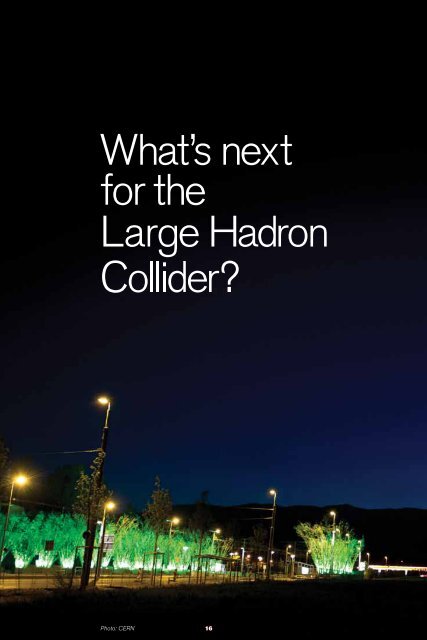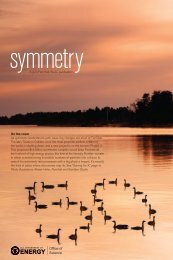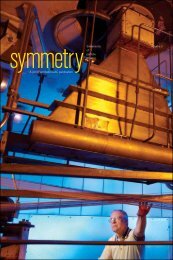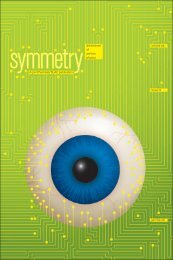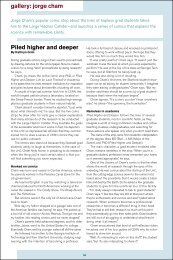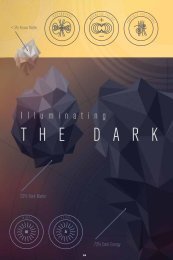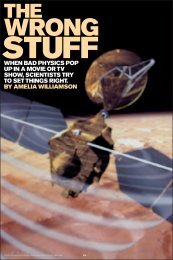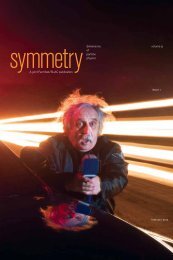PDF download - Symmetry Magazine
PDF download - Symmetry Magazine
PDF download - Symmetry Magazine
You also want an ePaper? Increase the reach of your titles
YUMPU automatically turns print PDFs into web optimized ePapers that Google loves.
Photo: CERN<br />
16
Experiments at the Large Hadron Collider<br />
made a major discovery, but the world’s<br />
highest-energy particle accelerator is just<br />
getting started.<br />
By Ashley WennersHerron<br />
and Kathryn Jepsen<br />
symmetry | spring 2013<br />
17
The Large Hadron Collider, the largest particle accelerator in the<br />
world, started colliding particles more than three years ago. Since<br />
then, scientists have published more than 700 papers detailing the<br />
knowledge they have gained at the cutting edge of particle physics.<br />
Undisputedly, the most famous insight so far has been the discovery<br />
of what could be the long-sought Higgs boson. This particle is thought<br />
to arise from the fluctuation of the invisible “Higgs field” that pervades the<br />
universe, imparting mass to particles that interact with it. Without the<br />
Higgs field, our world would be a much different place.<br />
Even during the excitement of that discovery, thousands of scientists—<br />
more than 1800 of whom are based in the United States—continued the<br />
important work of analyzing the continuing flood of new data pouring out<br />
of their detectors.<br />
There is still much to learn about the new, Higgs-like particle. And there<br />
is still much more territory to cover in the search for new physics. The<br />
LHC will expand its reach dramatically when scientists crank its energy<br />
from 4 trillion to 6.5 trillion electronvolts in 2015.<br />
Beyond discovery<br />
In the LHC, superconducting magnets steer two beams of protons in opposite<br />
directions along a 17-mile ring more than 300 feet beneath the border of<br />
Switzerland and France. The beams cross paths in four locations along<br />
the ring. When a proton from one beam collides with a proton from the<br />
other, the energy of the collision can convert into mass, creating for<br />
a moment new particles.<br />
Massive particles created in collisions are unstable and quickly decay<br />
into less massive particles, leaving a whole zoo of particles for scientists<br />
to study.<br />
Since the LHC turned on, the ATLAS, CMS, LHCb and ALICE experiments—<br />
along with the smaller experiments TOTEM and LHCf—have discovered<br />
a total of three particles.<br />
“At the LHC, the streetlamps are just beginning to turn on, and we can<br />
see under some of the lampposts now,” says John Ellis, a theorist and<br />
professor at King’s College London. “Eventually, the pools of light will join<br />
up and we’ll be able to see everything.”<br />
In December 2011, one of the lamps revealed something new. The ATLAS<br />
collaboration announced the first particle discovery at the LHC—a quark<br />
and antiquark bound together named X b (3P) (pronounced kye-bee-threepee).<br />
Although it had been predicted for years, it took the high rate of<br />
collisions in the LHC to finally expose the particle. Scientists are still studying<br />
it to understand how the quark and antiquark tie together through the<br />
strong nuclear force, which makes the nucleus of an atom stick together, too.<br />
The CMS collaboration found the limelight just a few months later, in May<br />
2012, when they announced the discovery of the excited baryon Ξ b (pronounced<br />
sai-bee), a particle composed of three quarks, including a bottom<br />
quark. Scientists are now analyzing the particle; their work may reveal<br />
insight into how quarks bind together.<br />
And then, in July 2012, both the CMS and ATLAS collaborations<br />
announced the discovery of a new particle that could be the Higgs boson.<br />
Searching for new particles is just one continuing function of the LHC<br />
experiments. Now that scientists have uncovered new particles, they have<br />
another focus—finding out more about them.<br />
The new Higgs-like particle, for example, seems to fulfill at least the<br />
minimum role of the Higgs boson, as it interacts with particles in more or<br />
less the expected way. But observations of the new particle’s properties—<br />
its spin, parity and detailed interactions—could show it to be a different kind<br />
of Higgs than the one predicted by the Standard Model, the theory used to<br />
explain the makeup and interaction of particles and forces in our universe.<br />
If it turns out that the particle is not the Standard Model Higgs boson,<br />
scientists will learn that there are new phenomena whose descriptions may<br />
require new underlying principles. One popular alternative model under<br />
18
The Large Hadron Collider drives<br />
two beams of particles on a<br />
collision course around a 17-mile<br />
ring located more than 300 feet<br />
underground at the border of<br />
France and Switzerland.<br />
Photo: CERN<br />
symmetry | spring 2013<br />
19
Physicist Despina<br />
Hatzifotiadou navigates a<br />
maze of color-coded wires<br />
at the ALICE detector, one<br />
of six detectors at the Large<br />
Hadron Collider.<br />
Photo: antoniosaba/CERN<br />
20
investigation is called supersymmetry. It posits that each particle of the<br />
Standard Model has a related, more massive partner particle. In this model<br />
and others, there would be more than one Higgs boson. Alternatively, it<br />
could be that the Higgs boson is made of other, even smaller particles.<br />
Or it could be that the Higgs exists in more than our three dimensions<br />
of space.<br />
“We could be looking at a new framework,” says Joao Varela, a physicist<br />
with the Portuguese institute LIP and CMS deputy spokesperson. “It may<br />
not be the Standard Model or even supersymmetry. It might be something<br />
else entirely.”<br />
Conversely, if the Higgs turns out to be the particle scientists expected<br />
to find, physicists will have finally discovered every piece predicted in the<br />
Standard Model.<br />
More than new particles<br />
Yet even with a Standard Model Higgs, questions will remain in particle<br />
physics theory.<br />
Particle physics research encompasses three intertwining frontiers:<br />
the energy frontier, the intensity frontier and the cosmic frontier. Energy<br />
frontier experiments involve converting energy into mass at particle colliders<br />
such as the LHC; intensity frontier experiments use intense beams of<br />
particles to study rare processes and make high-precision measurements;<br />
cosmic frontier experiments use the cosmos as a laboratory and also<br />
study particles that reach Earth from distant sources.<br />
Work at all three frontiers aims in part to resolve a major contradiction<br />
in particle physics theory. The masses of force-carrying particles such<br />
as the Higgs boson, the W boson and the Z boson are all relatively similar,<br />
between 80 and 125 times the mass of the proton. Within the Standard<br />
Model, there is no explanation for why the masses of these particles—each<br />
associated with a force that governs interactions between particles—<br />
should have these values, nor why the Higgs mass should be so similar to<br />
the other two. In fact, theorists have argued that these values are “unnatural”<br />
in the Standard Model, and that the findings beg for an explanation.<br />
Theorists have proposed many new models that can account for these<br />
strangely low masses. All of these new models require the addition of new<br />
fundamental particles to the Standard Model. Conveniently, some of the<br />
extra particles predicted are good candidates to fill the role of dark matter,<br />
the matter that scientists have found indirect evidence for in cosmic<br />
frontier experiments but have never observed directly.<br />
So far, LHC experiments have not found these extra fundamental particles.<br />
(The two new particles found thus far, other than the Higgs-like boson,<br />
are composite, not fundamental.) But even if they did, there would be<br />
another hitch: Adding particles to fix the problems of the inexplicably light<br />
Higgs and invisible dark matter causes a different kind of trouble. The<br />
contradiction appears in something called flavor physics.<br />
Some particles come in multiple copies with different masses. These<br />
iterations are called flavors. Neutrinos, rarely interacting particles that are<br />
a favorite subject of intensity frontier experiments, come in three flavors.<br />
Likewise, there are three types of electrically charged leptons: the electron,<br />
muon and tau. Quarks, the particles that make up atomic nuclei, come in<br />
different types as well: up, down, charm, strange, bottom and top.<br />
Sometimes a particle will transform from one flavor to the next. Based<br />
on the Standard Model, scientists can predict how often this should happen,<br />
if at all.<br />
Scientists’ current predictions are calculated based on the Standard<br />
Model. But if there’s something beyond that model, one or more undiscovered<br />
particles, scientists expect to find that their Standard Model predictions for<br />
flavor mixing do not precisely match their experimental results.<br />
So far, that has not been the case. Measurements of flavor mixing at<br />
intensity frontier experiments and energy frontier experiments—including<br />
LHCb, CMS and ATLAS—have conformed nicely with standard predictions.<br />
symmetry | spring 2013<br />
21
“It’s the tension between the frontiers that’s really exciting,” says Andrew<br />
Cohen, a theorist at Boston University. “We’re investigating this fundamental<br />
mystery of the energy scale of the W, Z and Higgs bosons on all three fronts.”<br />
Results from the LHC experiments will continue to provide essential<br />
contributions toward resolving this conflict. Studying the properties of the<br />
new, Higgs-like particle and conducting direct searches for new particles<br />
will be the tasks of the ATLAS and CMS experiments. Flavor physics and<br />
indirect searches for new particles are more the specialty of LHCb. In their<br />
own ways, CMS, ATLAS and LHCb are all working to make more and more<br />
precise measurements to more rigorously test the Standard Model.<br />
The ALICE experiment has a slightly different specialty: delving into<br />
understanding the behavior of the early universe. ALICE was designed to<br />
study collisions of heavy ions, which produce a very hot state of matter<br />
called the quark-gluon plasma. Scientists think the universe began in this<br />
state, a primordial soup from which everything around us grew. ALICE<br />
results, like those from the other LHC experiments, may have an important<br />
impact on all three frontiers of particle physics.<br />
More to come<br />
Starting in March 2013, the LHC’s long shutdown will give scientists, engineers<br />
and technicians the opportunity to upgrade the machine to run close to its<br />
design energy. Each beam will operate at 6.5 trillion electronvolts.<br />
Scientists expect to collect data from more than 200 quadrillion particle<br />
collisions after the machine switches back on in 2015. At higher energies,<br />
they will be able to see even more interesting events.<br />
“The same amount of data at a higher energy is worth more,” says Ian<br />
Hinchliffe, a physicist with Lawrence Berkeley National Laboratory<br />
and member of the ATLAS collaboration. “With the planned upgrades, we’ll<br />
increase the LHC’s sensitivity by a factor of 10.”<br />
Albert Einstein’s famous theory of relativity states that the energy of<br />
a particle is related to its mass; the two are different sides of the same<br />
coin. The LHC puts the theory to work, pumping up particles to high energies<br />
and smashing them into one another in order to transform that energy<br />
into mass in the form of new particles.<br />
Collisions at higher energies can create particles with more mass. At<br />
13 trillion electronvolts, the LHC will be able to access a new realm of<br />
masses and states of matter never before seen in manmade accelerators.<br />
“The increase of energy gives a much greater reach, particularly for<br />
heavy objects with a higher mass,” says Andy Lankford, a physicist with<br />
the University of California, Irvine, and deputy spokesperson for ATLAS.<br />
“It gives us the ability to explore the unknown.”<br />
A high-energy future<br />
Exploration at the LHC has only just begun.<br />
“There are many reasons to be excited for the next five to 10 years and<br />
beyond,” says Joe Incandela, a physicist with the University of California,<br />
Santa Barbara, and CMS spokesperson.<br />
Through careful studies, scientists will determine the properties of the<br />
new, Higgs-like particle. They will find out whether the Standard Model<br />
is a done deal or whether it has steered them astray. And they’ll have the<br />
opportunity to find the unexpected.<br />
Nature certainly has more mysteries for scientists to explore, and once<br />
the accelerator begins running near full capacity in 2015, researchers will<br />
have even better tools to search for new physics.<br />
“We are at the beginning,” says Aleandro Nisati, who leads the ATLAS<br />
collaboration’s studies of how the LHC upgrades will expand the potential<br />
of physics analyses. “This is a new, big chapter in high-energy physics.”<br />
22
University of California,<br />
Santa Barbara, physicist<br />
and CMS Spokesperson<br />
Joe Incandela watches a<br />
continually updating display<br />
of recent collision<br />
events on a screen in the<br />
CMS control room.<br />
Photo: CERN<br />
symmetry | spring 2013<br />
23


